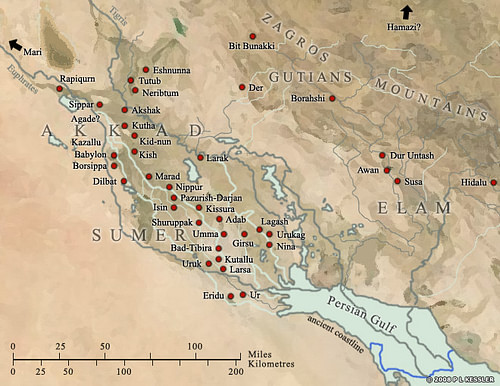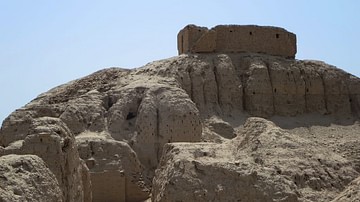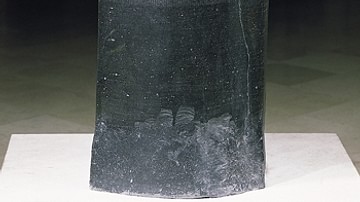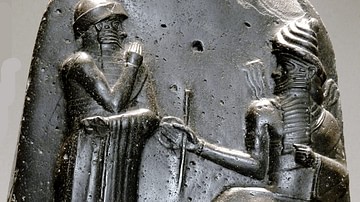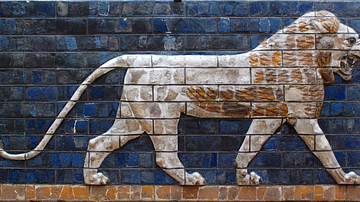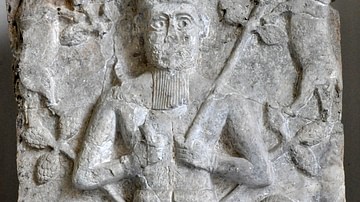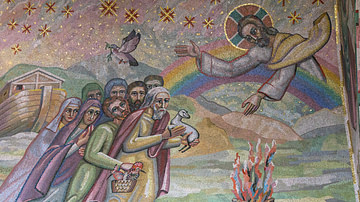The Atrahasis is the Akkadian/Babylonian epic of the Great Flood sent by the gods to destroy human life. Only the good man, Atrahasis (his name translates as `exceedingly wise') was warned of the impending deluge by the god Enki (also known as Ea) who instructed him to build an ark to save himself. Atrahasis heeded the words of the god, loaded two of every kind of animal into the ark, and so preserved life on earth.
Written down in the mid-17th century BCE, the Atrahasis can be dated by the colophon to the reign of the Babylonian King Hammurabi's great-grandson, Ammi-Saduqa (1646-1626 BCE) though the tale itself is considered much older, passed down through oral transmission. The Sumerian Flood Story (known as the `Eridu Genesis') which tells the same story, is certainly older (composed c. 2300 BCE) and Tablet XI of The Epic of Gilgamesh, which also relates the tale of the Great Flood, is even older than that.
The Epic of Gilgamesh was written c. 2150-1400 BCE but the Sumerian Flood story it relates is older, passed down orally until it appeared in writing. While the story itself concerns a flood of universal proportions (even scaring the gods who unleashed it) most scholars recognize that it was probably inspired by a local event: flooding caused by the Tigris and Euphrates rivers overflowing their banks.
While archaeological and geological evidence has shown such flooding was a fairly common occurrence, it is speculated that a particularly memorable flood , c. 2800 BCE, served as the basis for the story. No recognized scholar working in the present day maintains the argument that there was ever a world-wide flood such as Atrahasis and the other accounts depict (including the story of Noah and his Ark in the Biblical book of Genesis). The Mesopotamian scholar Stephanie Dalley writes:
No flood deposits are found in third-millennium strata, and Archbishop Ussher's date for the Flood of 2349 BC, which was calculated by using numbers in Genesis at face value and which did not recognize how highly schematic Biblical chronology is for such early times, is now out of the question. (5)
The cleric Dalley references is Archbishop James Ussher (l. 1581-1656 CE), famous for his Ussher Chronology which dates the creation of the world to 22 October 4004 BCE at 6:00 pm based on his dating of events in the Bible. Although Ussher's Chronology is still considered valid by Christians who uphold the Young Earth Theory of the age of the world, his work has been discredited by irrefutable evidence in a number of different disciplines since the 19th century CE.
The Atrahasis
The Atrahasis begins after the creation of the world but before the appearance of human beings:
When the gods, instead of man
Did the work, bore the loads
The god's load was too great, the work too hard, the trouble too much. (Tablet I, Dalley, 9)
The elder gods made the younger gods do all the work on the earth and, after digging the beds for the Tigris and Euphrates rivers, the young gods finally rebel. Enki, the god of wisdom, suggests the immortals create something new, human beings, who will do the work instead of the gods. One of the gods, We-Ilu (also known as Ilawela or Geshtu/Geshtu-e) known as "a god who has sense" offers himself as a sacrifice to this endeavor and is killed. The goddess Nintu (the mother goddess, also known as Ninhursag) adds his flesh, blood and intelligence to clay and creates seven male and seven female human beings.
At first the gods enjoy the leisure the human workers afford them but, in time, the people become too loud and disturb the gods's rest. Enlil, the king of the gods, is especially annoyed by the constant disturbance from below and so decides to lessen the population by sending first a drought, then pestilence and then famine down upon the earth.
After each of these plagues, the humans appeal to the god who first conceived of them, Enki, and he tells them what to do to end their suffering and return the earth to a natural, productive state. Enlil, finally, can stand no more and persuades the other gods to join him in sending a devastating flood to earth which will completely wipe out the human beings.
Enki takes pity on his servant, the kind and wise Atrahasis, and warns him of the coming flood, telling him to build an ark and to seal two of every kind of animal within. Atrahasis does as he is commanded and the deluge begins:
The flood came out...No one could see anyone else
They could not be recognized in the catastrophe
The Flood roared like a bull
Like a wild ass screaming, the winds howled
The darkness was total, there was no sun. (Tablet III,Dalley 31)
The mother goddess, Nintu, weeps for the destruction of her children ("she was sated with grief, she longed for beer in vain") and the other gods weep with her.
After the waters subside Enlil and the other gods realize their mistake and regret what they have done; yet feel there is no way they can un-do it. At this point Atrahasis comes out of his ark and makes a sacrifice to the gods. Enlil, though only just before wishing he had not destroyed humanity, is now furious at Enki for allowing any one to escape alive.
Enki explains himself to the assembly, the gods descend to eat of Atrahasis' sacrifice, and Enki then proposes a new solution to the problem of human overpopulation: create new creatures who will not be as fertile as the last. From now on, it is declared, there will be women who cannot bear children, demons who will snatch infants away and cause miscarriages, and women consecrated to the gods who will have to remain virgins. Atrahasis himself is carried away to paradise to live apart from these new human beings whom Nintu then creates.
Other Versions of the Story
The Epic of Gilgamesh retells the story, with more or less the same details, but the hero is Utnapishtim ("He Found Life") who is spirited away by the gods with his wife and lives forever in the land across the seas. Gilgamesh's quest for immortality leads him eventually to Utnapishtim but his journey does him no good as everlasting life is denied to mortals. The Sumerian version of the tale has Ziusudra ("The Far Distant") as the hero but tells the same story.
The best known tale of the Great Flood, of course, is from the biblical Book of Genesis 6-9 in which God becomes incensed with the wickedness of humanity and destroys them with a flood, except for the righteous Noah and his family. The biblical work draws on the earlier oral version of the Mesopotamian flood story which is echoed in the works cited above and which may also have influenced an Egyptian text known as The Book of the Heavenly Cow, a part of which dates to Egypt's First Intermediate Period (2181-2040 BCE).
The Book of the Heavenly Cow tells how, after the sun god Ra had created humans, they rebeled against him and he decided to destroy them. He sent the goddess Hathor as an extension of himself (known as The Eye of Ra) to slaughter humanity but, after she had killed many, he repented of the decision. He then had massive quantities of beer dyed red to look like blood and ordered it placed in Hathor's path. She drank the beer, fell asleep, and later woke up as the loving goddess and friend to humanity she is usually depicted as.
Almost every culture has some form of a Great Flood story and this is often cited as proof that there must have been some cataclysmic deluge at some point. This is not necessarily so, however, as it is just as possible that a popular flood story, repeated down through the ages, inspired storytellers in different regions. Dalley comments:
All these flood stories may be explained as deriving from the one Mesopotamian original, used in traveler's tales for over two thousand years, along the great caravan routes of Western Asia: translated, embroidered, and adapted according to local tastes to give a myriad of divergent versions, a few of which have come down to us. (7)
Atrahasis, as noted, is not the oldest version of the Mesopotamian flood story and the earlier, oral version almost certainly influenced other culture's versions including the Egyptian and Hebrew. In the Egyptian version, humanity's rebellion and Ra's mercy leads to a closer relationship with the gods and in the biblical version the same is suggested by God's covenant with Noah after the flood waters subside. In the Atrahasis, the gods allow humans continued existence with the stipulation that they will not live forever nor will they be allowed to reproduce as bounteously as before.
Conclusion
The story would have served, besides simply as entertainment, to explain human mortality, those misfortunes attendant on childbirth, even the death of one's child. Since overpopulation and the resultant noise had once brought down the terrible deluge which almost destroyed humanity, the loss of one's child could, perhaps, be more easily borne with the knowledge that such a loss helped to preserve the natural order of things and kept peace with the gods.
The myth would have served the same basic purpose which such stories always have: the assurance that individual human suffering has some greater purpose or meaning and is not simply random, senseless pain. The Atrahasis, like the story of Noah's Ark, is finally a tale of hope and of faith in a deeper meaning to the tragedies of the human experience.
